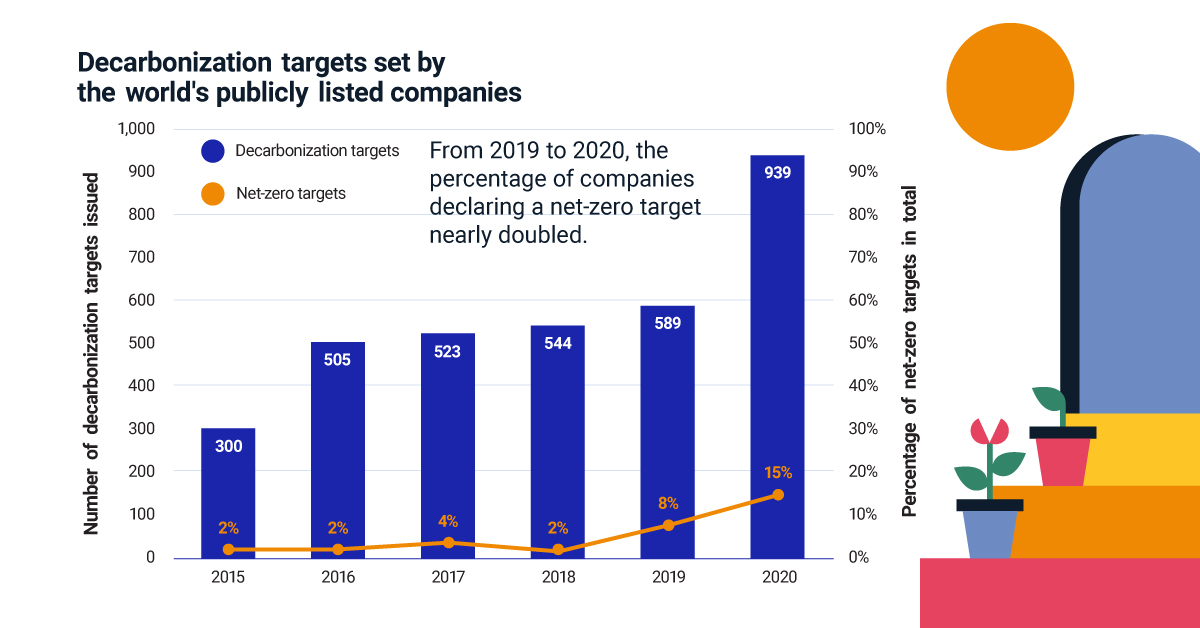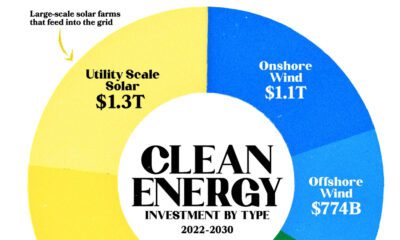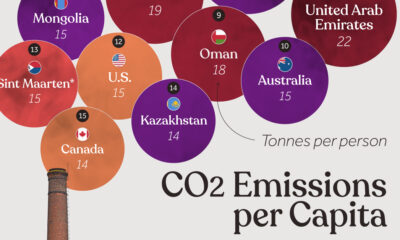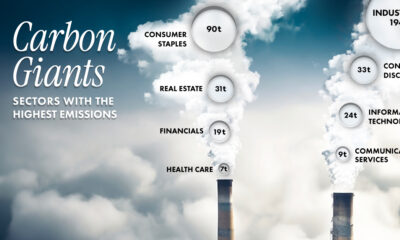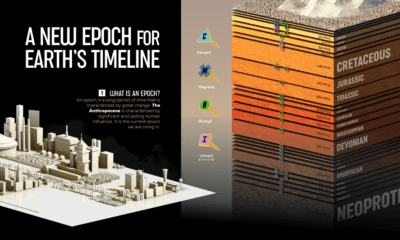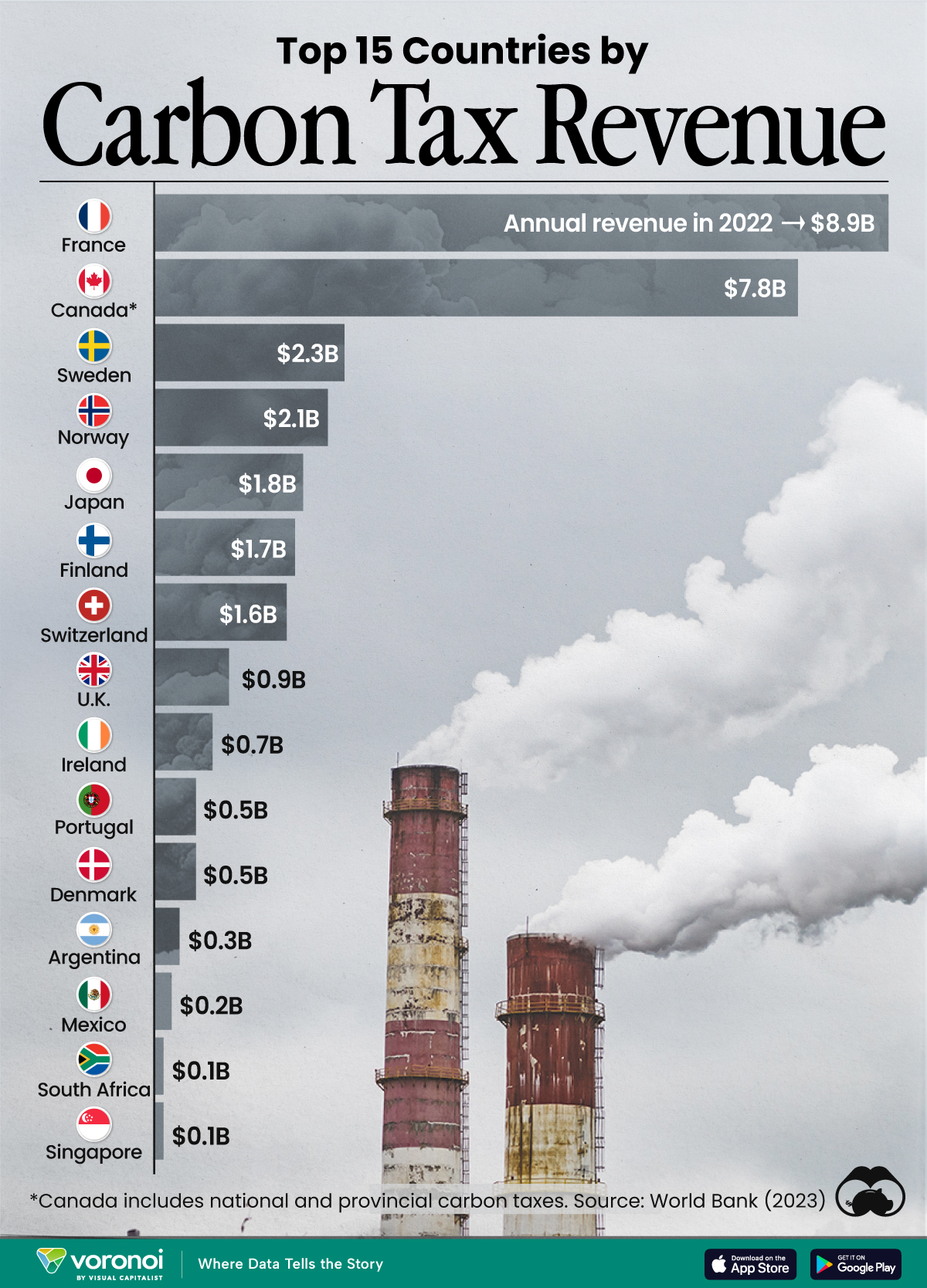Green
Net-Zero Emissions: The Steps Companies and Investors Can Consider

The Steps to Net-Zero Emissions
To help prevent the worst effects of climate change, a growing number of companies are pledging to achieve net-zero emissions by 2050. In fact, the percentage of companies declaring a net-zero target nearly doubled from 2019 to 2020.
With urgency building, how can companies and investors approach net-zero emissions? The above infographic from MSCI highlights the steps these two groups can take, from defining a strategy to reporting progress.
Net-Zero Emissions: A Clear Process
Setting a net-zero emissions target means reducing carbon emissions to the greatest extent possible, and compensating for the remaining unavoidable emissions via removal.
Companies and investors can take four broad steps to move toward their targets.
1. Define Strategy
To begin, companies can measure current emissions and identify priority areas where emissions can be reduced. For example, ABC chemical company determines that its greenhouse gas (GHG) emissions far exceed those of its competitors. In response, ABC chemical company prioritizes reducing GHG emissions during material processing.
Similarly, wealth and asset managers can assess climate risks:
- Risks of transitioning to a net-zero economy
- Risks of extreme weather events
They can then map out a strategy to curb climate risk. For example, XYZ asset manager determines that 33% of its portfolio may be vulnerable to asset stranding or some level of transition risk. XYZ decides to lower its transition risk by aligning with a 1.5 degrees Celsius (2.7 degrees Fahrenheit) warming scenario.
2. Set Target
With a strategy set, companies can pledge their net-zero emissions commitment and set interim goals. They can also specify how their pledge will be achieved. For example, ABC chemical company could set a net-zero emissions target by 2050. To increase short-term accountability, they set an interim target to halve carbon emissions by 2035.
Wealth and asset managers can also set targets and interim goals, as they apply to their portfolios. For instance, XYZ asset manager could set a goal to decarbonize its portfolio 5% by 2025, and 10% by 2030. This means that the companies within the portfolio are reducing their carbon emissions at this rate.
| Scenario | Warming Potential |
|---|---|
| Business as usual | 3.6℃ (6.5℉) |
| 10% decarbonization | 1.5℃ (2.7℉) |
As shown above, a 10% year-on-year decarbonization will align XYZ asset manager’s model portfolio with a 1.5 degrees Celsius warming scenario.
3. Implement
ABC chemical company takes immediate action consistent with its interim targets. For instance, the company can start by reducing the carbon footprint of its processes. This approach carries the lowest risks and costs. But to take larger strides toward its net-zero emissions goal, ABC could draw on renewable energy together with carbon-removal technologies as they are developed.
In the same vein, XYZ asset manager can move toward its decarbonization targets by adopting a benchmark index and reallocating capital. This could include:
- Increasing investment in clean technologies
- Re-weighting securities or selecting those that are “best in class” for ESG metrics
- Reducing risk exposure and targeting companies for shareholder engagement
- Selling holdings in companies with the greatest exposure
All of these actions will help XYZ become better aligned with its investment strategy.
4. Track and Publish Progress
Here, the actions for companies and investors converge. Both groups can measure and monitor progress, disclose results, and adjust as necessary.
For example, XYZ asset manager shares the following year-end results of its decarbonization strategy. The results compare the portfolio and its benchmark on their implied temperature rise and exposure to low-carbon transition categories.
| Portfolio | Benchmark | Difference (Portfolio - Benchmark) |
|
|---|---|---|---|
| Implied temperature rise | 3.2℃ (5.8℉) | 3.4℃ (6.1℉) | -0.2℃ (-0.4℉) |
| Exposure to companies classified as: | |||
| Asset stranding | 0.0% | 0.5% | -0.5% |
| Product transition | 6.1% | 8.1% | -2.0% |
| Operational transition | 5.2% | 7.0% | -1.8% |
| Neutral | 77.6% | 77.8% | -0.2% |
| Solutions | 11.1% | 6.6% | +4.5% |
Asset stranding is the potential for an asset to lose its value well ahead of its anticipated useful life because of the low carbon transition. Companies with product transition risk may suffer from reduced demand for carbon-intensive products and services, while companies with operational transition risk may have increased operational or capital costs due to the low carbon transition.
XYZ asset manager’s portfolio has less risk than the benchmark. XYZ has also significantly reduced its exposure to transition risk to 11.3%, down from 33% in step 1. However, with an implied temperature rise of 3.2 degrees Celsius, the portfolio is far from meeting its 1.5 degrees Celsius warming goal. In response, XYZ begins to intensify pressure on portfolio companies to cut their GHG emissions by at least 10% every year.
A Climate Revolution for Net-Zero Emissions
The time to drive the transition to net-zero emissions is now. By the end of this century, the world is on track to be up to 3.5 degrees Celsius warmer. This could lead to catastrophic flooding, harm to human health, and increased rates of mortality.
As of July 2021, just 10% of the world’s publicly listed companies have aligned with global temperature goals. Preventing the worst effects of climate change will demand the largest economic transformation since the Industrial Revolution. Companies, investors and other capital-market participants can drive this change.
Green
Ranking the Top 15 Countries by Carbon Tax Revenue
This graphic highlights France and Canada as the global leaders when it comes to generating carbon tax revenue.
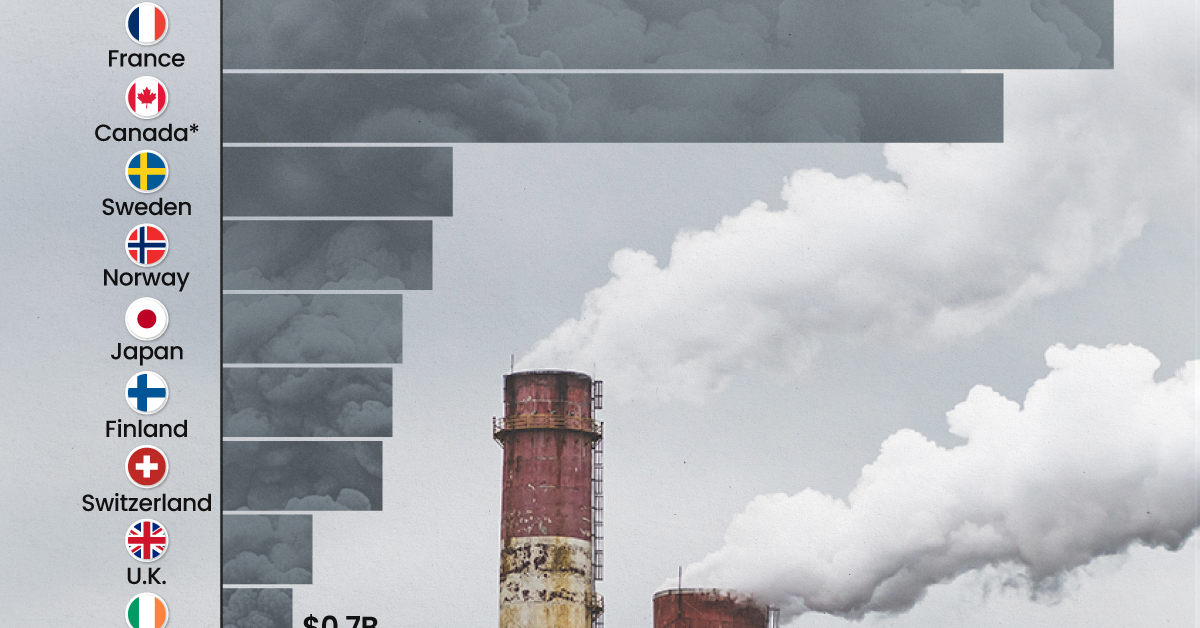
Top 15 Countries by Carbon Tax Revenue
This was originally posted on our Voronoi app. Download the app for free on iOS or Android and discover incredible data-driven charts from a variety of trusted sources.
Carbon taxes are designed to discourage CO2 emissions by increasing the cost of carbon-intensive activities and incentivizing the adoption of cleaner energy alternatives.
In this graphic we list the top 15 countries by carbon tax revenue as of 2022. The data is from the World Bank’s State and Trends of Carbon Pricing Report, published in April 2023.
France and Canada Lead in Global Carbon Tax Revenue
In 2022, the top 15 countries generated approximately $30 billion in revenue from carbon taxes.
France and Canada lead in this regard, accounting for over half of the total amount. Both countries have implemented comprehensive carbon pricing systems that cover a wide range of sectors, including transportation and industry, and they have set relatively high carbon tax rates.
| Country | Government revenue in 2022 ($ billions) |
|---|---|
| 🇫🇷 France | $8.9 |
| 🇨🇦 Canada | $7.8 |
| 🇸🇪 Sweden | $2.3 |
| 🇳🇴 Norway | $2.1 |
| 🇯🇵 Japan | $1.8 |
| 🇫🇮 Finland | $1.7 |
| 🇨🇭 Switzerland | $1.6 |
| 🇬🇧 United Kingdom | $0.9 |
| 🇮🇪 Ireland | $0.7 |
| 🇩🇰 Denmark | $0.5 |
| 🇵🇹 Portugal | $0.5 |
| 🇦🇷 Argentina | $0.3 |
| 🇲🇽 Mexico | $0.2 |
| 🇸🇬 Singapore | $0.1 |
| 🇿🇦 South Africa | $0.1 |
In Canada, the total carbon tax revenue includes both national and provincial taxes.
While carbon pricing has been recognized internationally as one of the more efficient mechanisms for reducing CO2 emissions, research is divided over what the global average carbon price should be to achieve the goals of the Paris Climate Agreement, which aims to limit global warming to 1.5–2°C by 2100 relative to pre-industrial levels.
A recent study has shown that carbon pricing must be supported by other policy measures and innovations. According to a report from Queen’s University, there is no feasible carbon pricing scenario that is high enough to limit emissions sufficiently to achieve anything below 2.4°C warming on its own.
-

 Mining2 weeks ago
Mining2 weeks agoCharted: The Value Gap Between the Gold Price and Gold Miners
-

 Real Estate1 week ago
Real Estate1 week agoRanked: The Most Valuable Housing Markets in America
-

 Business1 week ago
Business1 week agoCharted: Big Four Market Share by S&P 500 Audits
-

 AI1 week ago
AI1 week agoThe Stock Performance of U.S. Chipmakers So Far in 2024
-

 Misc1 week ago
Misc1 week agoAlmost Every EV Stock is Down After Q1 2024
-

 Money2 weeks ago
Money2 weeks agoWhere Does One U.S. Tax Dollar Go?
-

 Green2 weeks ago
Green2 weeks agoRanked: Top Countries by Total Forest Loss Since 2001
-

 Real Estate2 weeks ago
Real Estate2 weeks agoVisualizing America’s Shortage of Affordable Homes

